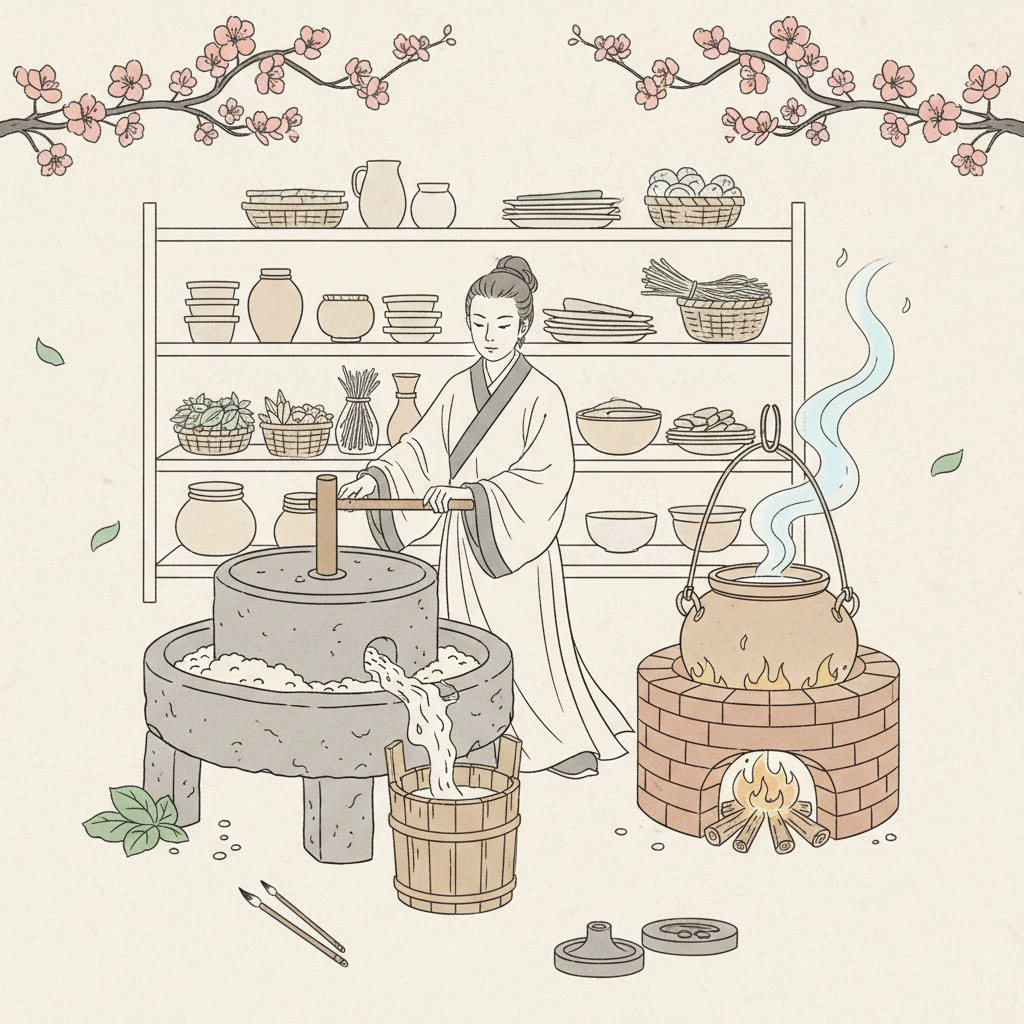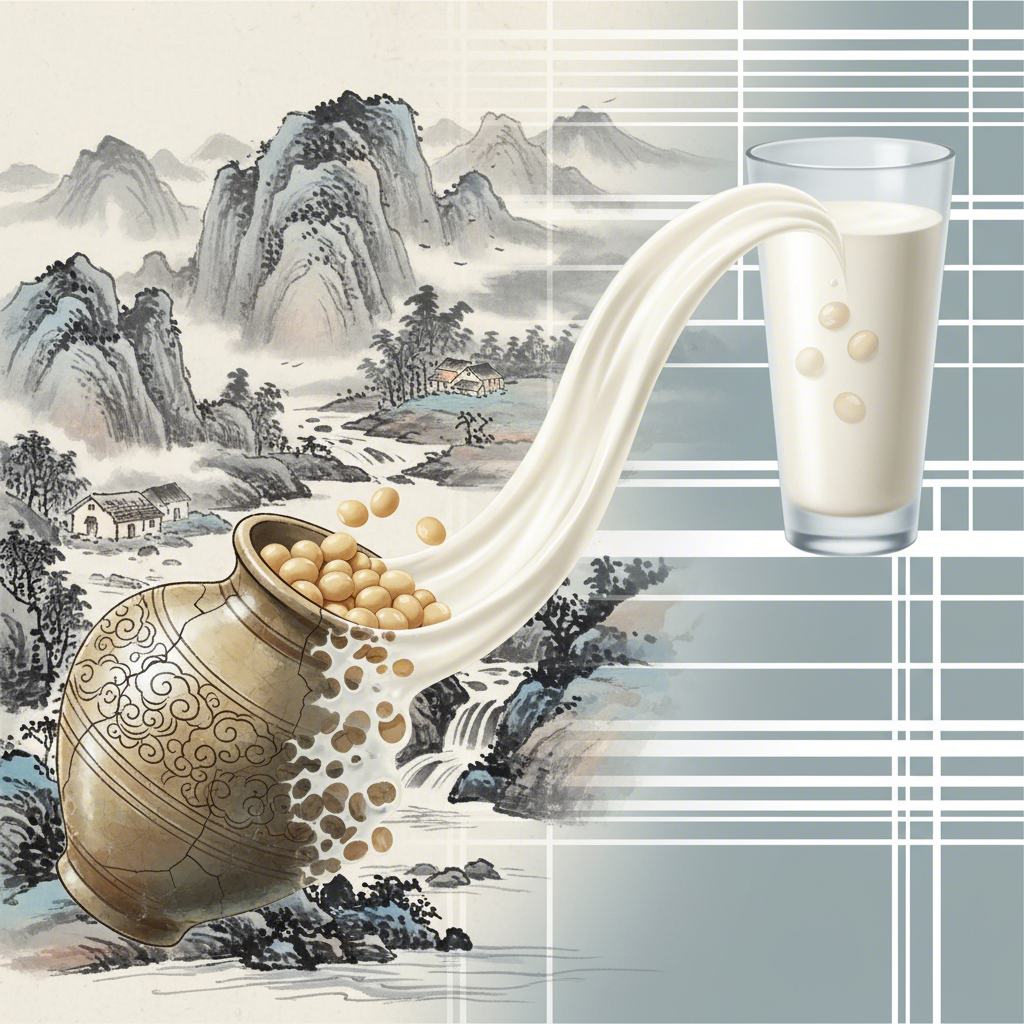TL;DR
The history of soy milk traces back to ancient China, with the earliest records dating to the Han Dynasty around A.D. 82. It originated as a watery broth called doujiang, an intermediate product of tofu making. Introduced to the Western world in the early 20th century, it became a vital protein source and dairy substitute during the food shortages of the World Wars. Through modern innovations in processing and marketing, it has since evolved into a mainstream global beverage.
The Ancient Origins of Soy Milk in China
The story of soy milk begins not as a distinct beverage, but as a fundamental step in the creation of tofu. The earliest known reference to this soybean liquid, called doujiang (literally “bean broth”), appears around A.D. 82 in the writings of Wang Ch’ung during China’s Han Dynasty. Further evidence includes engravings on an Eastern Han Dynasty stone slab that depict the process in ancient kitchens. For centuries, doujiang was the product of soaking, grinding, and filtering soybeans—a milky, aqueous extract that would then be coagulated to form tofu. While a popular legend attributes the invention of both tofu and soy milk to Prince Liu An in the 2nd century B.C., there is no historical evidence to support this claim, as detailed by the Soyinfo Center.
The widespread adoption of soy-based foods in East Asia was deeply rooted in cultural and physiological factors. Dairy farming was not a significant part of the region’s agriculture, partly due to the high prevalence of lactose intolerance among the population. Unlike in Europe, where animal milk became a staple, most East Asians lacked the lactase enzyme necessary to digest it properly. Soybeans, one of the “Five Sacred Grains” of the Zhou Dynasty, offered an abundant, inexpensive, and easily digestible source of protein. The soybean plant’s ability to enrich the soil by fixing nitrogen also made it an ecologically sound crop for the region.
Traditionally, doujiang was consumed as a hot, savory breakfast soup, often garnished with pickled vegetables, dried shrimp, and spring onions. It was also served sweetened. A classic pairing, which remains popular today, is fresh, hot doujiang served with youtiao (deep-fried dough sticks) for dipping. This culinary tradition highlights its original role as a hearty, soup-like food rather than a direct substitute for animal milk. It was a nutritious and integral part of daily life long before it was ever packaged in a carton.

Introduction to the Western World
While soy milk was a staple in Asia for centuries, its journey to the West is a relatively recent phenomenon, driven by scientific curiosity and wartime necessity. The term “soy-bean milk” first appeared in English in an 1897 USDA report, but its commercial introduction was spearheaded by Li Yu-ying, a Chinese biologist and engineer. In 1910, he established the world’s first soy dairy, “Caséo-Sojaïne,” in Paris and secured the first patents for soy milk manufacturing in the subsequent years. This marked the beginning of soy milk’s transformation into a commercial product outside of Asia.
In the United States, pioneers like Dr. Harry W. Miller, a physician who had worked in China, began producing soy milk. However, its popularity surged dramatically during World War I and World War II. As food rationing limited access to meat and dairy, soy milk emerged as a heroic and essential alternative. According to an article in Tasting Table, it provided crucial protein and nutrition to Americans, especially in schools, when traditional sources were scarce. Prominent figures like Henry Ford, a vocal critic of the dairy industry, also championed soy, further boosting its profile.
The path to acceptance was not without challenges. The powerful dairy industry in the U.S. actively resisted the newcomer, leading to legal battles over its name. Producers were often compelled to label their product as “Soya Lac” or “Soygal” rather than “soy milk” to avoid direct competition. It wasn’t until a series of court cases between 1949 and 1974 that non-dairy milks were legally recognized as distinct food products, solidifying their place in the market. This period of struggle and adaptation was critical in paving the way for soy milk’s future as a mainstream beverage.
The Modern Era: From Niche Product to Mainstream Staple
The post-war era marked a significant turning point for soy milk, transforming it from a wartime substitute into a modern commercial success. A key innovation came from Hong Kong, where Vitasoy began marketing its soy milk as a sterilized, shelf-stable soft drink in the 1950s. This strategic shift, moving it from the dairy case to the beverage aisle, proved immensely popular and fueled its growth across Asia. Technological advancements were equally crucial. The adoption of Tetra Pak cartons in the 1960s and 1970s eliminated the need for refrigeration and dramatically extended shelf life, making soy milk more convenient than ever.
Another major hurdle was its distinct “beany” flavor, which was often unappealing to Western palates. This taste is caused by the lipoxygenase enzyme in soybeans. A breakthrough occurred in 1966 when Cornell researchers identified this enzyme and developed heat-based processes to neutralize it, resulting in a milder, more milk-like flavor. This innovation was instrumental in its acceptance in Europe and North America, where brands like Alpro (Belgium) and Eden Foods (U.S.) began to emerge.
The 1990s cemented soy milk’s mainstream status in the United States, largely driven by a growing awareness of its health benefits. Research linking soy consumption to lower cholesterol levels led the FDA to allow health claims on packaging, and brands like Silk successfully introduced refrigerated soy milk in cartons right alongside dairy milk. As detailed in Today’s Dietitian, this move made it a direct and visible competitor, changing consumer perceptions. Though now sharing shelf space with almond, oat, and other plant-based milks, soy milk’s journey from an ancient Chinese broth to a global staple is a remarkable story of cultural exchange and technological innovation. For those inspired by this history to create fresh plant-based beverages at home, resources like Soy Milk Quick offer comprehensive guides to the best plant milk makers available.
Frequently Asked Questions
1. What is the history of soy milk?
The history of soy milk began in ancient China, where the earliest records of a soybean broth called doujiang date to the Eastern Han dynasty (around A.D. 82). It was originally an intermediate product in the process of making tofu. It remained a traditional East Asian breakfast food for centuries before being introduced to the West in the early 20th century. Its popularity grew significantly during the World Wars as a dairy substitute and has since become a mainstream beverage worldwide through modern production and marketing.
2. What is the oldest non-dairy milk?
While soy milk has a long history, it is not the oldest non-dairy milk. That distinction belongs to coconut milk. Evidence suggests that coconut milk has been a culinary staple in Southeast Asia, India, and other tropical regions for more than 5,000 years, predating the documented history of soy milk by several millennia.
